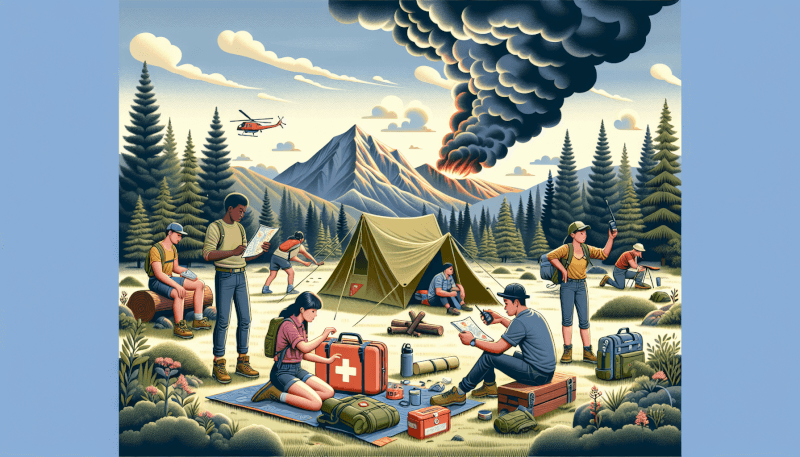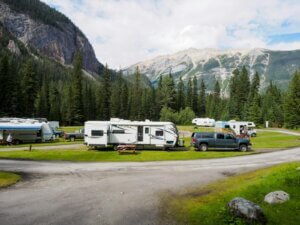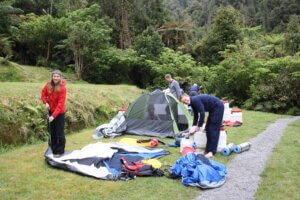Imagine you and your friends are out on your first camping trip, eager to embark on an adventure and create lasting memories. But amidst the excitement and fun, it’s essential to be prepared for any unexpected situations that may arise. Whether it’s losing your way in the wilderness or dealing with a medical emergency, knowing what to do can make all the difference. In this article, we will explore some essential tips and guidelines to ensure that beginner campers are equipped and ready to handle emergencies while enjoying the great outdoors.
Preparing for Emergencies
Researching the Campsite
Before embarking on any camping trip, it’s crucial to thoroughly research the campsite you’ll be staying at. Familiarize yourself with the terrain, weather patterns, and any potential risks or hazards in the area. This research will enable you to make informed decisions regarding your safety and wellbeing during your trip.
Creating a Safety Plan
Once you have gathered information about the campsite, it’s time to create a comprehensive safety plan. The safety plan should include important details such as emergency contact numbers, the location of the nearest medical facilities, and alternatives for communication in case of limited cell reception. By having a safety plan in place, you can quickly respond to emergencies and minimize potential risks.
Packing Emergency Supplies
In addition to your camping gear, it’s essential to pack a well-stocked emergency kit. Your emergency kit should include essentials such as a first aid kit, a flashlight, extra batteries, a whistle, a multi-tool, matches, a waterproof map, and a compass. It is also advisable to carry extra food, water, and clothing in case of unexpected emergencies or delays. By packing these emergency supplies, you can ensure that you are well-prepared for any unforeseen situations that may arise during your camping trip.
Handling Common Campsite Emergencies
Dealing with Minor Cuts and Scrapes
Minor cuts and scrapes are common occurrences in the great outdoors, but they should not be taken lightly. If you or someone in your group sustains a minor injury, make sure to clean the wound immediately with clean water and soap, if available. Apply an antiseptic ointment and cover the wound with a sterile bandage or dressing. Remember to change the dressing regularly to prevent infection.
Treating Burns and Sunburn
Spending time outdoors exposes you to the risk of burns and sunburn, particularly if proper precautions are not taken. In case of minor burns, cool the affected area with cold water or a cold compress for at least ten minutes. For sunburns, seek shade and apply aloe vera gel or a soothing lotion to alleviate discomfort. If blisters or severe pain develop, seek medical attention promptly.
Addressing Allergic Reactions
Allergic reactions can occur suddenly, even in the midst of a camping trip. If you or anyone in your group experiences difficulty breathing, hives, or swelling, it may be an allergic reaction. Administer any necessary medications, such as an epinephrine auto-injector if available, and seek immediate medical assistance. It is critical to identify and avoid known allergens to prevent allergic reactions during your camping trip.
Managing Insect Bites and Stings
Encountering insects is inevitable when spending time in nature, and bites or stings can lead to discomfort and potential allergic reactions. If bitten or stung, clean the affected area with soap and water, apply a cold compress to reduce swelling, and take over-the-counter antihistamines to alleviate itching. Keep an eye out for signs of a severe allergic reaction, such as difficulty breathing or swelling, and seek medical help if necessary.
Handling Sprains and Strains
Sprains and strains are common injuries that can occur when hiking or participating in outdoor activities. If you or someone in your group experiences a sprain or strain, remember the R.I.C.E. method: rest the injured area, apply ice or a cold compress, compress the area with a bandage, and elevate the injured limb to reduce swelling. If the pain is severe or the injury worsens, seek medical attention for further evaluation and treatment.
Responding to Environmental Emergencies
Recognizing Hypothermia and Frostbite
In colder climates or during winter camping trips, hypothermia and frostbite are significant risks. Hypothermia occurs when body temperature drops to dangerous levels, while frostbite happens when tissue freezes. Recognize the symptoms of hypothermia such as shivering, confusion, and uncontrollable shivering, and seek immediate medical attention. To prevent frostbite, dress in warm, layered clothing, protect exposed skin, and avoid prolonged exposure to extreme cold temperatures.
Managing Heat Exhaustion and Heatstroke
Camping in hot weather can lead to heat-related emergencies such as heat exhaustion and heatstroke. Heat exhaustion symptoms include excessive sweating, fatigue, dizziness, and nausea. Move to a shaded area, remove excess clothing, drink fluids, and cool the body with a cold compress or damp cloth. Heatstroke is a severe condition that requires immediate medical attention. If someone is experiencing hot and dry skin, a rapid pulse, confusion, or fainting, call emergency services right away.
Navigating Dangerous Weather Conditions
Campers must be prepared for sudden changes in weather conditions, as they can pose significant dangers. Familiarize yourself with the signs of impending dangerous weather, such as darkening skies, thunder, or sudden gusts of wind. In case of severe weather, seek shelter indoors or in your emergency shelter. Avoid open areas, tall trees, and bodies of water during thunderstorms. Stay informed by monitoring weather forecasts and be prepared to adjust your plans accordingly.
Identifying Poisonous Plants
Knowing how to identify poisonous plants is crucial to prevent accidental exposure and subsequent allergic reactions. Familiarize yourself with common poisonous plants in the area, such as poison ivy, poison oak, and stinging nettles. Learn to recognize their distinctive leaves and avoid direct contact. If you come into contact with a poisonous plant, wash the affected area immediately and seek medical attention if a severe reaction occurs.
Dealing with Wildlife Encounters
Encountering wildlife can be both exciting and potentially dangerous while camping. It is essential to learn about the local wildlife and their behavior to ensure your safety. Keep a safe distance from wild animals and never approach or attempt to feed them. Store food securely to prevent attracting wildlife to your campsite. If a wildlife encounter becomes threatening or aggressive, make yourself appear larger, make noise, and slowly back away.
Emergency Communication and Seeking Help
Establishing Communication Protocols
Establishing communication protocols is vital to staying connected during emergencies. Before heading out, discuss communication methods and designate meeting points with your camping companions. Ensure everyone knows how to operate radios, whistles, or any other agreed-upon method of communication. Regularly check in with each other, especially when exploring the campsite. Clear communication can help expedite help in case of an emergency.
Signaling for Help
In situations where verbal communication may be limited or ineffective, knowing how to signal for help is crucial. The universal distress signal is three evenly spaced signals made with a whistle, mirror, flashlight, or any other reflective object that can catch attention. Carry a signaling device in your emergency kit and practice using it before your camping trip to familiarize yourself with the process.
Using Electronic Devices for Assistance
In emergencies, electronic devices such as cell phones or satellite-based communication devices can be valuable tools for seeking help. Ensure that your devices are fully charged and that you have access to reliable cellular coverage. Download camping-specific apps or offline maps that can provide valuable information and even work without internet connection. However, it is important to note that in some remote camping areas, cell phone service may be limited or nonexistent.
Seeking Help from Nearby Campers
If you encounter an emergency and nearby campers are available, don’t hesitate to seek their assistance. They may have additional resources, such as medical supplies or communication devices, that can help in the situation. Approach nearby campers calmly and explain the emergency situation clearly. Most campers are friendly and willing to lend a hand in times of need.
Contacting Emergency Services
In more severe emergencies, it may become necessary to contact emergency services. Save the emergency contact number for the area you are camping in your phone or write it down in your safety plan. When contacting emergency services, provide them with accurate information about your location, the nature of the emergency, and any relevant details that can assist the responders. Stay on the line until instructed otherwise and follow their guidance.
Emergency Shelter and Survival Skills
Building a Basic Emergency Shelter
In case of unexpected emergencies or being stranded, knowing how to build a basic emergency shelter is crucial for survival. Look for natural features in your surroundings, such as trees and rock formations, to provide support and shelter. Use materials like branches, leaves, and tarpaulin to create a sturdy and waterproof shelter. Ensure that your shelter is well-ventilated and protected from wind and rain.
Finding and Purifying Water
In emergency situations, finding a clean water source is essential for survival. Look for nearby streams, springs, or lakes, but be cautious of stagnant or untreated water. Purify water by boiling it for at least five minutes, using water purification tablets, or using a portable water filter. Remember to prioritize hydration, as water is vital for your overall well-being.
Locating Food Sources
While it is crucial to prioritize water and shelter, it is also important to consider food sources in emergency situations. Familiarize yourself with edible plants in the area and learn basic wilderness foraging skills. Look for edible fruits, nuts, and edible insects. Avoid consuming unknown plants and animals to prevent food poisoning and potential health problems.
Navigating and Orienting with a Compass
If you find yourself lost or disoriented, having basic navigation skills can be a lifesaver. Learn how to use a compass to determine your direction and follow established trails or landmarks to find your way back to safety. Familiarize yourself with reading maps and understanding topographic features to assist in navigation. Remember, a compass is a valuable tool, but it is equally important to read and interpret the land around you.
Using Fire for Warmth and Signaling
Fire can provide warmth, light, and can be used as a signaling tool in emergencies. Learn how to start a fire using various techniques, such as with matches, a lighter, or a fire starter. Ensure you have a designated fire pit or fire ring, and be mindful of fire regulations and any fire bans in effect. In an emergency, a well-managed fire can aid in warmth, cooking food, and attracting attention for rescue.
Dealing with Medical Emergencies
Performing CPR
Knowing how to perform CPR (Cardiopulmonary Resuscitation) is a valuable skill that can save lives. CPR is used to revive individuals who have experienced cardiac arrest or stopped breathing. It involves chest compressions and rescue breaths to maintain blood circulation and oxygen supply to the body. Consider taking a CPR certification course to gain hands-on experience and confidence in performing this life-saving technique.
Handling Choking Incidents
Choking can occur when a foreign object obstructs the airway. If someone is choking, perform the Heimlich maneuver by standing behind the person, placing your hands above their navel, and delivering upward thrusts to dislodge the obstruction. If the person becomes unresponsive, begin CPR immediately and seek professional medical help.
Administering First Aid for Severe Bleeding
In the event of severe bleeding, quick and appropriate first aid is crucial. Apply direct pressure to the wound using a clean cloth or your hands. Elevate the affected limb, if possible, to reduce blood flow. If bleeding does not stop, apply additional pressure and consider using a tourniquet as a last resort. Seek immediate medical attention as severe bleeding may require professional medical intervention.
Recognizing Symptoms of Heart Attacks and Strokes
Heart attacks and strokes are serious medical emergencies that require immediate attention. Common signs of a heart attack include chest pain, shortness of breath, and discomfort in the upper body. In the case of a stroke, look for sudden numbness or weakness, confusion, difficulty speaking or understanding, and severe headaches. If you or someone around you experiences these symptoms, call emergency services immediately.
Managing Fractures and Dislocations
In the unfortunate event of a fracture or dislocation, immobilization and prompt medical attention are crucial. Gently stabilize the injured area using splints, if available, and avoid unnecessary movement. If possible, elevate the injured limb to reduce swelling. Call for emergency medical assistance and do not attempt to realign or reset the fracture or dislocation yourself.
Managing Fire-related Emergencies
Campfire Safety and Prevention
Campfires are enjoyable and useful, but they can also present fire-related emergencies. Always follow safety guidelines, such as keeping the fire within a designated fire pit or ring, away from flammable materials. Clear the area around the fire of any debris, and never leave a fire unattended. Ensure that the fire is fully extinguished before leaving the campsite or going to sleep.
Extinguishing Unwanted Fires
In the event of an unwanted fire or a fire getting out of control, acting swiftly is crucial. Evaluate the situation to determine if it is safe to extinguish the fire using available resources, such as water, sand, or a fire extinguisher. If the fire is spreading rapidly or poses a significant risk, evacuate the area immediately and call emergency services.
Escape Routes and Evacuation Plans
Always familiarize yourself with possible escape routes and evacuation plans when camping. Identify multiple exit paths from your campsite and establish meeting points with your camping companions. In case of an emergency that requires evacuation, follow your predetermined plan and gather at the designated meeting point. Ensure that all members of your group are accounted for.
Dealing with Smoke Inhalation
Smoke inhalation can have severe health consequences, so it’s important to know how to respond. If you find yourself in a smoky environment, cover your mouth and nose with a cloth or bandana to minimize smoke inhalation. Stay low to the ground where the air is less smoky and crawl towards an exit if possible. Seek medical attention promptly if symptoms such as difficulty breathing, coughing, or wheezing persist.
First Aid for Burns
In case of burns, it is essential to administer appropriate first aid promptly. For minor burns, rinse the affected area with cool water for several minutes to reduce heat and alleviate pain. Apply a sterile non-stick dressing or clean cloth to protect the burn. Do not burst any blisters that may have formed. For severe burns, call emergency services and keep the burn elevated and covered to prevent infection.
Handling Water-related Emergencies
Preventing Drowning Incidents
Drowning is one of the leading causes of death in water-related emergencies. To prevent these incidents, always wear appropriate life jackets when engaging in water activities. Avoid swimming alone and supervise children closely. Be aware of the water conditions, such as strong currents or sudden deep drops, and avoid swimming in unfamiliar or dangerous areas.
Rescuing a Person in Water
If someone is in distress in the water, it’s crucial to respond quickly and safely. If possible, throw a floatation device, such as a life ring or a flotation cushion, to aid the person in staying afloat. Avoid entering the water yourself unless you are a trained and confident swimmer or have the necessary equipment to do so safely. Call emergency services and provide them with accurate information about the situation.
Performing Basic Water Rescues
If you are confident in your swimming abilities and have the necessary skills, performing a basic water rescue can be lifesaving. Reach the person in distress by extending a long object, such as a sturdy branch or a rope. If necessary, swim to the person while ensuring your own safety. Grab them from behind or under the arms and swim them back to safety. Once out of the water, check for signs of breathing and initiate CPR if necessary.
Administering First Aid for Near Drowning
Even if someone appears fine after a near-drowning incident, it is crucial to administer first aid. Seek medical help immediately, as complications can arise following a near-drowning incident. If the person is unconscious but breathing, place them in the recovery position and monitor their vital signs. Be prepared to administer CPR if the person stops breathing or shows no signs of circulation.
Reacting to River and Flash Floods
River and flash floods can occur suddenly and pose significant dangers. It is important to be aware of weather conditions and heed any warnings or advisories in place. If caught in a flood, move to higher ground immediately and seek shelter. Avoid crossing flooded areas, as fast-moving water can easily sweep you off your feet. If necessary, signal for help and wait for assistance from rescue teams.

Dealing with Equipment and Navigation Issues
Addressing Equipment Malfunctions
Equipment malfunctions can occur at any time, potentially leaving you in a challenging situation. Always inspect and maintain your camping equipment before setting out to ensure everything is in proper working condition. If an equipment malfunction does occur, try to troubleshoot the issue. If the problem persists and compromises your safety, consider alternatives or seek help from nearby campers.
Navigating without a Map or Compass
Losing or misplacing your map or compass can be disorienting. However, there are alternative navigation methods you can employ. Look for natural markers, such as prominent rock formations or distinctive trees, to guide your direction. Observe the sun’s movement to determine east and west, and use your wristwatch to estimate approximate times. Trails and animal paths can also serve as indicators of direction.
Lost in the Woods: Survival Strategies
If you find yourself lost while camping, it is crucial to stay calm and think rationally. Stop and assess your situation, retracing your steps if possible. If you cannot find your way back, prioritize finding shelter and a water source. Remain in one location and make yourself visible to search teams by creating signals or using reflective objects. If you have a whistle, blow it in regular intervals to attract attention.
Dealing with Injured or Stranded Companions
If a member of your camping group becomes injured or stranded, it is important to stay calm and assess the situation. Ensure the person is stable and not in immediate danger. Provide first aid as necessary and seek help from nearby campers or emergency services, if available. Establish a communication plan to update others about the situation and follow any medical instructions you receive.
Escaping Dangerous Terrains
Dangerous terrains, such as steep cliffs or treacherous slopes, require caution and careful navigation. If you find yourself in a dangerous terrain, slow down and assess the area for potential hazards. Look for alternative routes or safer paths to traverse. Consider using walking sticks or ropes for stability and assistance. If you are unsure about your ability to safely navigate the terrain, it may be best to turn back or seek help from experienced individuals.
Developing a Safety Mindset
Staying Calm and Collected
In any emergency situation, it is crucial to stay calm and collected. Panic can cloud judgment and hinder your ability to make rational decisions. Take deep breaths, assess the situation, and remind yourself that you are prepared and capable of handling the emergency. Staying calm will help you think clearly and respond effectively to any challenges that may arise.
Assessing Risks and Planning Ahead
A safety mindset involves continuously assessing risks and planning ahead to minimize potential dangers. Before embarking on any camping trip, evaluate the potential risks associated with the campsite, weather conditions, and activities planned. Take appropriate precautionary measures, such as packing necessary safety equipment and informing others about your plans and expected return time. Regularly reassess your surroundings to identify any new risks that may arise during your trip.
Building Skills and Knowledge
Developing and improving your camping skills and knowledge is essential for ensuring your safety in emergencies. Take first aid and CPR courses to gain confidence in handling medical situations. Learn essential survival skills, such as starting a fire, building a shelter, and navigating without a map or compass. The more knowledgeable and skilled you are, the better equipped you will be to respond effectively during emergencies.
Practicing Emergency Scenarios
Practicing emergency scenarios before your camping trip can significantly increase your level of preparedness. Carry out simulated drills with your camping companions to rehearse actions and responses in case of emergencies. These simulations will help you identify any gaps in your emergency plan and allow you to make necessary adjustments. Remember, practice makes perfect, and being proactive can make a substantial difference in emergency situations.
Being Aware of Surroundings
Being aware of your surroundings is a fundamental aspect of maintaining your safety while camping. Stay observant and attuned to changes in weather conditions, terrain, and the behaviors of wildlife. Monitor the movements and wellbeing of your camping companions to ensure their safety as well. By being aware, you can anticipate potential risks and respond promptly to prevent emergencies from occurring.
In conclusion, emergencies can happen unexpectedly, but with proper preparation, knowledge, and a safety mindset, you can navigate through various camping emergencies. Research the campsite beforehand, create a comprehensive safety plan, and pack essential emergency supplies. Learn how to administer first aid for various minor and major injuries, recognize symptoms of environmental emergencies, and develop skills such as navigation and fire management. Understand the importance of communication, both within your camping group and for seeking outside help. Finally, adopt a safety mindset by staying calm, assessing risks, building skills, practicing emergency scenarios, and being aware of your surroundings. Remember, being prepared and informed is the best defense against any camping emergency. Happy camping!







